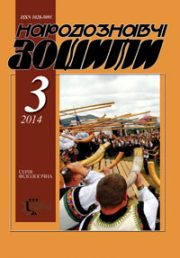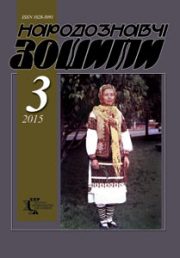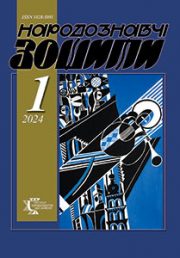The Ethnology Notebooks. 2022. № 1 (163), 50—56
UDK 069:061.23(=161.2:438)
DOI https://doi.org/10.15407/nz2022.01.050
MUSEUM OF THE SOCIETY OF «LEMKIVSHCHYNA» IN SANOK: PREREQUISITES FOR ESTABLISHMENT
KOZAKEVYCH Olena
- ORCID ID: https://orcid.org/0000-0002-8742-4337
- Candidate of Arts (Ph. D), Researcher,
- Ethnology Institute of NAS of Ukraine,
- Folk Art Department,
- 15, Svobody Avenue, 79000, Lviv, Ukraine,
- Contacts: e-mail: kozakevych.olena@gmail.com
Abstract. In the article, establishment distinctions of «Lemkivshchyna» Museum in Sanok at the beginning of the 1930s were analyzed on the basis of archival materials. Prerequisites for the establishment of the institution on socio-cultural factors background and key areas of its functioning in the context of Ukrainian museology were outlined. Special attention is given to the museums, the main purpose of which were to preserve the items of Ukrainian art and Ukrainian culture. From this point of view, the 1920s and 1930s are fascinating, when regional museums began their activities, focusing their collection work mainly on the areas in which they were coming from. This gave the opportunity to explore the area, to establish contact with the clergy, intellectuals and residents, and, accordingly, to acquire works of art. The «Lemkivshchyna» Museum in Sanok was the same one. In 1939, there were 14 this type of Ukrainian museums in the territory of the Second Polish-Lithuanian Commonwealth. The history of the museum inextricably linked with Lev Getz. He became the inspiration, one of the founders and the only permanent director — from the establishment of the institution to its liquidation.
The relevance of scientific research is due to the need to study the activities of the Society «Lemkivshchyna» Museum as one of the active centers for the preservation of Lemko’s artistic heritage in the interwar period.
The novelty of the publication consists of the introduction into scientific circulation of archival materials, in which were recorded the prerequisites for the establishment of the institution; were conveyed the atmosphere of public and cultural life of that time, which revolved around the founding of the museum and the accompanying work of its ideological inspirers.
The article purpose is to consider the ways of development and sociocultural background of the «Lemkivshchyna» Museum formation.
The object of the research is the reasons for the founding and functioning of the «Lemkivshchyna» Museum. The subject is the development of Ukrainian museums in the 1930s in the context of museum work in the 1920s and 1930s and the preservation of cultural heritage.
Source base of the research is literary, archival documents, reports, periodicals, photographs from the funds of museums and research institutions of Ukraine and Poland. The prerequisites for the establishment of the «Lemkivshchyna» Museum outlined in the article are only a separate scientific investigation into the study of this issue.
Keywords: the Society «Lemkivshchyna» Museum, Lev Getz, museology, collections, Lemko`s art, folk art, sacred art, Ukrainian cultural heritage.
Received 11.01.2022
REFERENCES
- Sidor, O. (2012). About the Lemkivshchyna Museum in Sanok (abbreviated version). Bonfire, 1 (76), 4—7. Gorlici[in Ukrainian].
- Sidor, O. (1995). Lemkivshchyna Museum in Sanok. Sights of Ukraine, 3, 2—18. Kyiv [in Ukrainian].
- Kozytsky, A. (1999). Ukrainian local folklore museums of Galicia in the interwar period. Bulletin of Lviv University (Issue 34, pp. 467—477). Lviv [in Ukrainian].
- Nadopta, A. (2012). The role of public, scientific organizations and the church in the formation of the Ukrainian ethnographic museum of Galicia in the late ХІХ — 30’s of XX century. The Ethnology Notebooks, 4 (106), 758—774. Lviv [in Ukrainian].
- Nadopta, A. (2013). A few touches to the activities of the society and the museum «Lemkivshchyna» in Sanok. Lemko calendar for 2013 (Pp. 69—75) [in Ukrainian].
- Mykytyuk, I. (2017). Leo Goetz’s artistic path. Bulletin of the Lviv National Academy of Arts (Issue 31, pp. 174—181). Lviv [in Ukrainian].
- Gakh, I. (2016). Pencil and coal lived in his hands. URL: http://zbruc.eunode/47215 [in Ukrainian].
- Gakh, I. (2021). Lev Getz and his «Lemkivshchyna»: 1925—1939. Retrieved from: https://zbruc.eu/node/103129 [in Ukrainian].
- Archives of the Historical Museum in Sanok (Archives of the MHS). Files of the «Lemkivshchyna» Museum in Sanok from 1931—1939, 372 [in Ukrainian and Polish].
- Archives of the Historical Museum in Sanok (Archives of the MHS). List of documents, 323 [in Ukrainian and Polish].
- Romaniak, А. (2018).Sanok — archival photographs. Local government, education, organizations, institutions. Sanok[in Polish].






